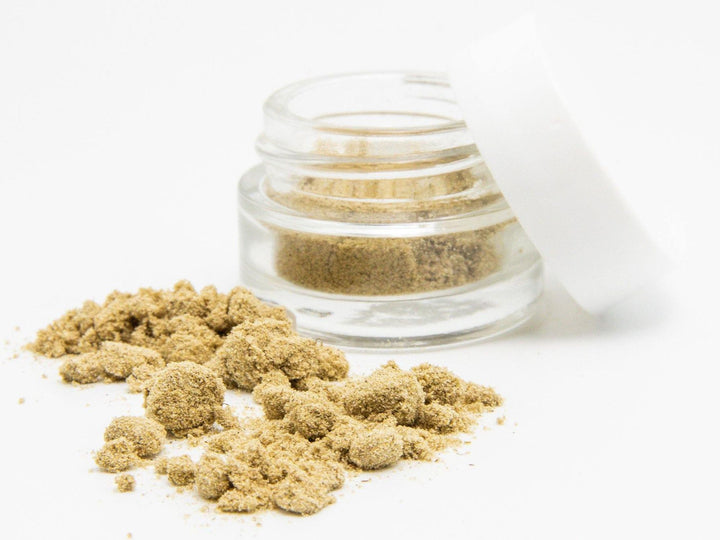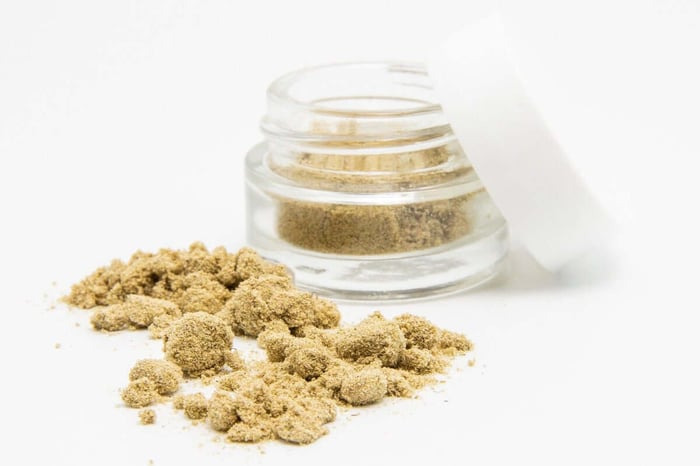Welcome to the world of CBG kief! If you’re new to this fascinating substance, you’re in the right place. This guide will walk you through everything you need to know about CBG kief, including where it comes from, how it's harvested, its uses, and the benefits it offers. By the end, you’ll be well-versed in this potent product and maybe even tempted to try it for yourself.
What is CBG Kief?
CBG kief is a fine, powdery substance collected from the hemp plant's flowers. Specifically, it comes from trichomes, which are tiny, crystal-like structures on the surface of the hemp flower. These trichomes are rich in cannabinoids, including cannabigerol (CBG) and its acidic precursor, cannabigerolic acid (CBGA).
CBG kief is sometimes referred to as pollen in cannabis culture. This term stems from its appearance and characteristics. Kief, including CBG kief, consists of the resinous trichomes found on cannabis flowers. These trichomes are tiny structures that contain cannabinoids, terpenes, and other compounds responsible for the plant's aroma, flavor, and effects.
The term "pollen" is used because kief resembles fine, powdery grains, similar to pollen. When collected, CBG kief can have a golden to dark blonde color, which further resembles pollen. This nickname is more commonly used informally among cannabis enthusiasts and consumers.
Whether called CBG kief or pollen, this concentrated form of cannabinoids offers a potent and versatile option for various consumption methods, including smoking, vaping, or infusing into edibles and topicals. Its high cannabinoid content makes it desirable for those seeking robust effects and therapeutic benefits from hemp-derived products.
Harvesting CBG Kief
The process of harvesting CBG kief involves sifting the dried hemp flowers through fine screens. This separates the trichomes from the plant material, resulting in a concentrated, powdery substance. The kief is typically dark blonde in color and can be extremely potent. In this case, our CBG kief contains 32% CBG, (more than double the potency of the flowers) making it a powerful addition to your cannabinoid regimen.
How to Use CBG Kief
There are numerous ways to incorporate CBG kief into your routine:
- Smoking or Vaping: Add it to your favorite smoking or vaping blend for an extra cannabinoid boost.
- Edibles: Infuse it into butter or oil to create potent edibles.
- Topicals: Mix it with carrier oils to make your own CBG-infused skincare products.
- DIY Caps: Add it to capsules for a potent supplement
Recipe: CBG-Infused Coconut Oil
Ingredients:
- 5 grams of CBG kief
- 1 cup of coconut oil
Instructions:
- Decarboxylate the Kief: Spread the kief on a baking sheet and heat it in an oven at 240°F (115°C) for 30-40 minutes. This process converts CBGA into CBG.
- Infuse the Oil: In a double boiler, combine the decarboxylated kief and coconut oil. Heat gently for 2-3 hours, stirring occasionally.
- Strain: Use a fine mesh strainer or cheesecloth to remove any plant material.
- Store: Pour the infused oil into a glass jar and store it in a cool, dark place.
Dosage Calculations
To understand the potency of your CBG kief, let's calculate the mg of CBG per different amounts:
- 5 grams of CBG kief: 5,000 mg * 0.32 = 1,600 mg of CBG
- 15 grams of CBG kief: 15,000 mg * 0.32 = 4,800 mg of CBG
- 4 ounces of CBG kief (113.4 grams): 113,400 mg * 0.32 = 36,288 mg of CBG
Understanding CBG and CBGA
The Basics
CBGA, also known as cannabigerolic acid, and CBG, cannabigerol, are cannabinoids found in cannabis sativa aka Hemp. This compound is found in less than 1% in most strains, but recent progress in hemp genetics has produced some CBG dominant hemp strains. For example, our White CBG strain contains 15% CBG and very little CBD or THC.
CBGA to CBG with Heat
All hemp varieties naturally produce acidic versions of cannabinoids, including THC, CBD, and CBG. The plant does not produce these cannabinoids directly; they are the result of a chemical reaction called decarboxylation, which primarily occurs through heat or sunlight. While decarboxylation is essential for THCA to transform into psychoactive THC, CBGA undergoes the same process to become CBG. Both cannabinoids have their own unique benefits.
Benefits of CBGA and CBG
Psychoactive Effects of CBGA and CBG
CBGA and CBG are known as non-psychoactive cannabinoids, meaning they don't make you feel "high." However, there's more to them than that. These cannabinoids can enhance the overall effects of hemp flower, often making you feel more energetic.
In a recent study, CBG was shown to interact strongly with CB2 receptors in our body, which are involved in managing things like inflammation and pain. It also has a weaker interaction with CB1 receptors, which are linked to the psychoactive effects of cannabis. This means CBG might boost the effects of THC, which does make you feel "high," when they are used together.
Both CBGA and CBG work well with CB2 receptors, just like other cannabinoids such as CBDA and CBD, and they offer unique benefits for health and wellness.
Anticonvulsive Properties of CBGA
CBGA has gained attention in numerous clinical studies for its remarkable anticonvulsant properties. In one study, CBGA was found to be the most potent among several cannabinoids, including CBDVA and CBGVA, in terms of their anticonvulsant potential. This suggests that CBGA may offer greater efficacy than CBD in treating seizures. Additionally, CBGA has shown the ability to affect certain drug targets relevant to epilepsy, further highlighting its potential as an anticonvulsant.
CBGA and Metabolic Function
Ongoing research has shown that CBGA has important effects on how our bodies handle metabolism. For example, in studies focusing on aldose reductase (ALR2), an enzyme linked to diabetes complications, CBGA was found to block ALR2's activity significantly. This suggests CBGA could potentially be useful in treating metabolic disorders.
Additionally, CBGA acts like a stimulant on PPARα/γ receptors, which are targeted by medications designed to manage metabolic disorders. This dual effect on the receptor enhances CBGA's potential to control how our bodies process fats and sugars, which can help manage conditions like high blood sugar levels.
CBGA and Neuroprotection
CBGA has also shown promise in exhibiting neuroprotective properties through various modes of action. Studies have indicated that CBGA (the main compound in kief), along with other cannabinoids, increases the number of viable bone marrow-derived mesenchymal stem cells (BMMSCs). These cells play a crucial role in immunomodulation and neuroprotection, making CBGA a potential candidate for the treatment of neuroimmunological and neurodegenerative diseases, such as multiple sclerosis.
CBGA has been discovered to strongly reduce sensitivity in TRP (transient receptor potential) channels, which play a role in many neurological disorders. For instance, activating the TRPA1 channel is believed to regulate inflammation in Alzheimer’s disease through astrocytes, while the TRPV1 channel is linked to epilepsy, nerve activity, and signal transmission in the brain. CBGA’s ability to affect TRP channels suggests it could potentially alleviate symptoms of these neurological conditions.
CBG vs. CBGA: Benefits and Differences
The Entourage Effect and Energy Boost
While CBDA and CBD are often associated with calming and relaxing effects, CBGA and CBG (present in kief) offer a more energetic side to the experience. Users describe CBGA and CBG as providing similar attributes to CBDA and CBD but with an added boost of energy. This makes them valuable ingredients when formulating hemp product with specific purposes in mind such as mood and focus.
Why Choose CBG Kief?
CBG kief offers a potent and versatile way to experience the benefits of cannabinoids. With its high CBGa content, it provides significant therapeutic potential, whether you're looking to enhance your mental clarity, reduce inflammation, or explore other health benefits. The raw form, CBGa, offers unique advantages particularly for those interested in its anti-inflammatory and digestive health properties.
Incorporating CBG kief into your wellness routine can be a game-changer. Whether you choose to smoke it, vape it, or infuse it into your favorite recipes, you'll be tapping into a powerful natural resource with a wide array of benefits. CBG Kief is a rare and valuable offering in the consumer space.
So, are you ready to explore the world of CBG kief? With its potent effects and versatile uses, it’s a fantastic addition to any wellness toolkit. Dive in and discover the difference it can make for you!
Raw CBGa Kief

$38.00
CBG Kief – Unprocessed & Potent CBG Kief is a raw, concentrated form of CBG derived from our White CBG hemp strain. This fine, blonde powder is collected by sifting dried hemp flowers through a 150-micron screen, separating much of… read more

